MARIANI’S
February 8, 2009
NEWSLETTER

Bing Crosby, Grace Kelly, and Frank Sinatra in "High Society" (1956)
HAPPY V ALENTINE'S D AY!
~~~~~~~~~~~~~~~~~~~~~~~~~~~
ARCHIVE: Readers may now access
an
Archive of all past newsletters--each annotated--dating back to July,
2003, by simply clicking on www.johnmariani.com/archive
SUBSCRIBE AND
UN-SUBSCRIBE: You may subscribe anyone you wish
to this newsletter--free of charge--by
clicking here.
DIVERSION MAGAZINE: To Read my article "The Year of the Pig" in the January/February issue of Diversion Magazine, click here.
~~~~~~~~~~~~~~~~~~~~~~~~~~~
In
This Issue
SCOTLAND
CELEBRATES IN 2009 By Robert Mariani
MY
10 FAVORITE ROMANTIC RESTAURANTS AROUND THE WORLD by
John Mariani
NEW YORK CORNER:
Vermilion by
John Mariani
NOTES FROM THE WINE CELLAR: Navarra Wines Quickly Adapt to 21st Century Global Market by John Mariani
QUICK BYTES
~~~~~~~~~~~~~~~~~~~~~~~~~~~~~~~~~~
SCOTLAND
CELEBRATES IN 2009
By Robert Mariani
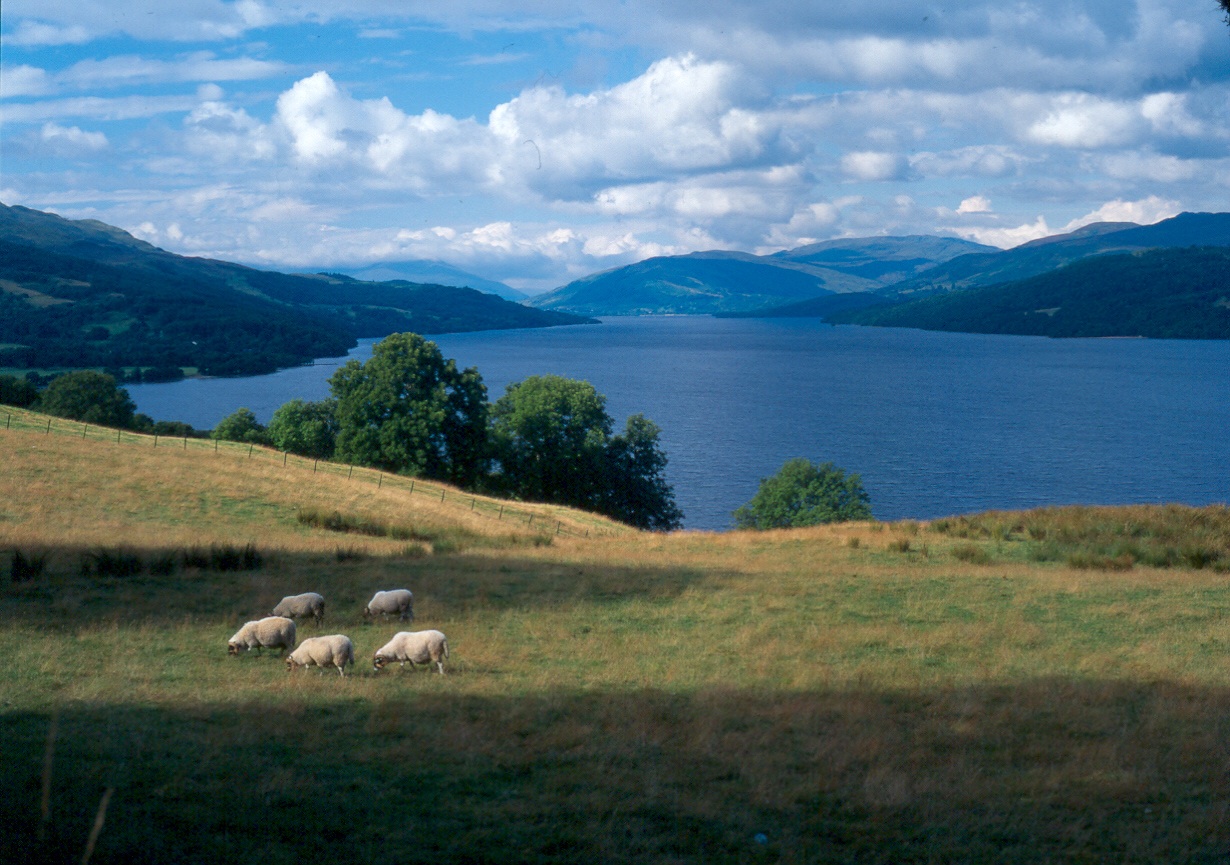
No, that last is not a misprint. Anyone who still thinks of Scotland as simply the home of haggis and oatmeal will be surprised at the level and variety of food offered. Take the relatively new Dakota Hotel and Restaurant in Edinburgh, for instance. Lit from within and rising like a huge iridescent ice cube in the night sky, the Dakota offers handsome, modern accommodations and a restaurant (below) that was voted Scotland’s Best of the year in 2008. The menu adds some interesting variations on a number of standard dishes. For starters, in addition to things like steamed mussels in white wine and fish and shellfish soup, they offer a duck liver parfait with fig jam; or an appetizing squid salad with a tart dipping sauce. Basic entrées like steak tartare, fish and chips, and rib eye steak were contrasted with a hearty gnocchi dish accompanied by roasted tomatoes, basil and mozzarella.
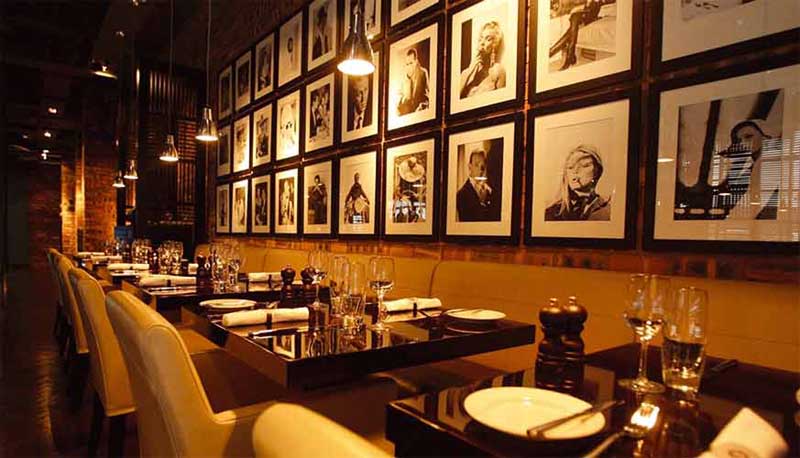
As elsewhere in the British Isles,
Scotland is
placing more emphasis on local food resources for freshness and flavor.
Nowhere is this more evident than at Edinburgh’s Farmers’ Market, a
series of 70 or so small tents and trailers set up in the shadow of the
imposing Edinburgh Castle in the heart of the city. Every Saturday
people stroll the cobblestone walkway, sampling and buying fresh
produce, eggs from free-range chickens, honey, cheeses, organic beers,
liqueurs, breads, chocolates and chutneys.
Located next door to the stately Edinburgh Castle is
the institution known as “The Scotch Whisky
Experience,” a good place to learn about the past history and present
state-of-the-art of Scotland’s most famous beverage. This museum is
presently undergoing renovation and will re-open this spring in
time for the Homecoming Year and will provide insights into the secrets
of the drink whose Scottish name, uisge beatha, means “the Water of
Life.”
The museum also houses the Amber
Restaurant with a menu that features local produce, beef, lamb
and
game, and offers pairings of whiskies with certain food. Seafood lunch
entrées included mussels with Islay
whisky and spring onion sauce; or trout fillet with new potato salad,
whisky mustard and honey dressing; and smoked Scottish salmon and prawn
with lemon dressing. Amber’s own vegetable garden offered up a roasted
shallot and Brie tart with red onion marmalade and salad;
roasted butternut squash with wild mushroom and garlic sauce; warm
goat's cheese on toasted herb bread with salad; and even a “Vegetarian
Haggis” with turnip and potato mash, served with a whisky sauce. From
the Amber Meat Larder we enjoyed a hearty beef and wild mushroom
casserole with puff pastry; and sausage with onion gravy and mashed
potatoes.
It doesn’t take long to get away from
the urban bustle of Edinburgh. In less than an hour you can be in the
wide-open countryside of the Kingdom of Fife, where golf was
allegedly invented. Here you can experience more local flavors at
places like Loch Leven’s Larder, a
family-owned farm stand that’s
becoming a casual dining/shopping destination. There is a strong
philosophical commitment here to use as much home-grown, in-season
vegetables, herbs, meats and eggs as possible.
The unpretentious, cafeteria-like Loch
Leven dining room looks out over the rolling farmlands from which most
of the menu items have been harvested. It’s a great place for a nice,
relaxed lunch or brunch with menu choices like hearty soups and home
made bread; panini with
local bacon, Brie, and cranberry sauce; Summer
Isle smoked salmon with avocado and crème fraîche;
Pudledub smoked ham with farmhouse cheese and chutney; and
desserts such as scones and jam; cheesecake and “Millionaire
shortbread,” all freshly made on the farm’s
premises.
Ardeonaig, a Hidden Treasure
 About another hour’s drive west from Loch Leven, on the
banks of South Loch Tay in the farm town of Perthshire sits the Ardeonaig Hotel and
Restaurant. There have been settlements in this
rustic area since prehistoric times— indeed, you can still see remnants
in the fields of ancient stone circles and rock markings that go back
many centuries. Early records show that there’s been an Inn at
Ardeonaig since at least 1649 when it was a stopover place for cattle
drovers on their way to market. As we pulled up to the little doorway
of the centuries-old hotel, a twilight dew was settling on
the mossy slate roofs. The only sound was the steady whisper of the
rapids that run alongside the inn and down into Loch Tay a few hundred
yards behind the Inn.
About another hour’s drive west from Loch Leven, on the
banks of South Loch Tay in the farm town of Perthshire sits the Ardeonaig Hotel and
Restaurant. There have been settlements in this
rustic area since prehistoric times— indeed, you can still see remnants
in the fields of ancient stone circles and rock markings that go back
many centuries. Early records show that there’s been an Inn at
Ardeonaig since at least 1649 when it was a stopover place for cattle
drovers on their way to market. As we pulled up to the little doorway
of the centuries-old hotel, a twilight dew was settling on
the mossy slate roofs. The only sound was the steady whisper of the
rapids that run alongside the inn and down into Loch Tay a few hundred
yards behind the Inn.
Obviously, you’d have to have known
about the Ardeonaig
Inn, because its location is not exactly on any main
tourist routes. It is, however, definitely worth a special visit for a
number of reasons, not least its strong commitment to
serving great local food in a truly comfortable and convivial setting.
Chef/owner Pete Gottgens, who grew up in the hotel
business in South Africa and has run several restaurants in London
before coming here, has found what he calls “the perfect natural
larder for a chef with the world’s finest fish, meat, produce, fruit
and dairy all close at hand.” Gottgens took the Inn over a few years
ago with the aim of creating his own perfect version of a welcoming and
unpretentious country inn and restaurant. Without compromising the
antique feel of the Inn, he’s added numerous updates including five
South African-style huts behind the Inn on the way down to the Loch,
each a spacious, octagon-shaped habitat beautifully appointed
with deep bathtubs, romantic lighting, and luxurious radiant heating
beneath the floors.
Chef Gottgens’s energy and enthusiasm is
almost palpable
as he exclaims, “I can put vegetables and produce that was in the
ground this morning on the table this afternoon. We’re just an hour
from either coast for seafood and I not only know every one of my
fishermen by their first name, I even know what kind of car they
drive!” Meats and game also come from nearby suppliers and the Inn now
has its own herd of 150 black-faced sheep, and he is starting its own
herd of cattle, as well. Completely self-taught, Gottgens has cooked
around in
South Africa and in London for several years, but perhaps his most
distinctive credential is his seven-year stint as personal chef for
Nelson Mandela, during which he created state dinners for many of the
world’s most illustrious leaders, diplomats, kings and queens.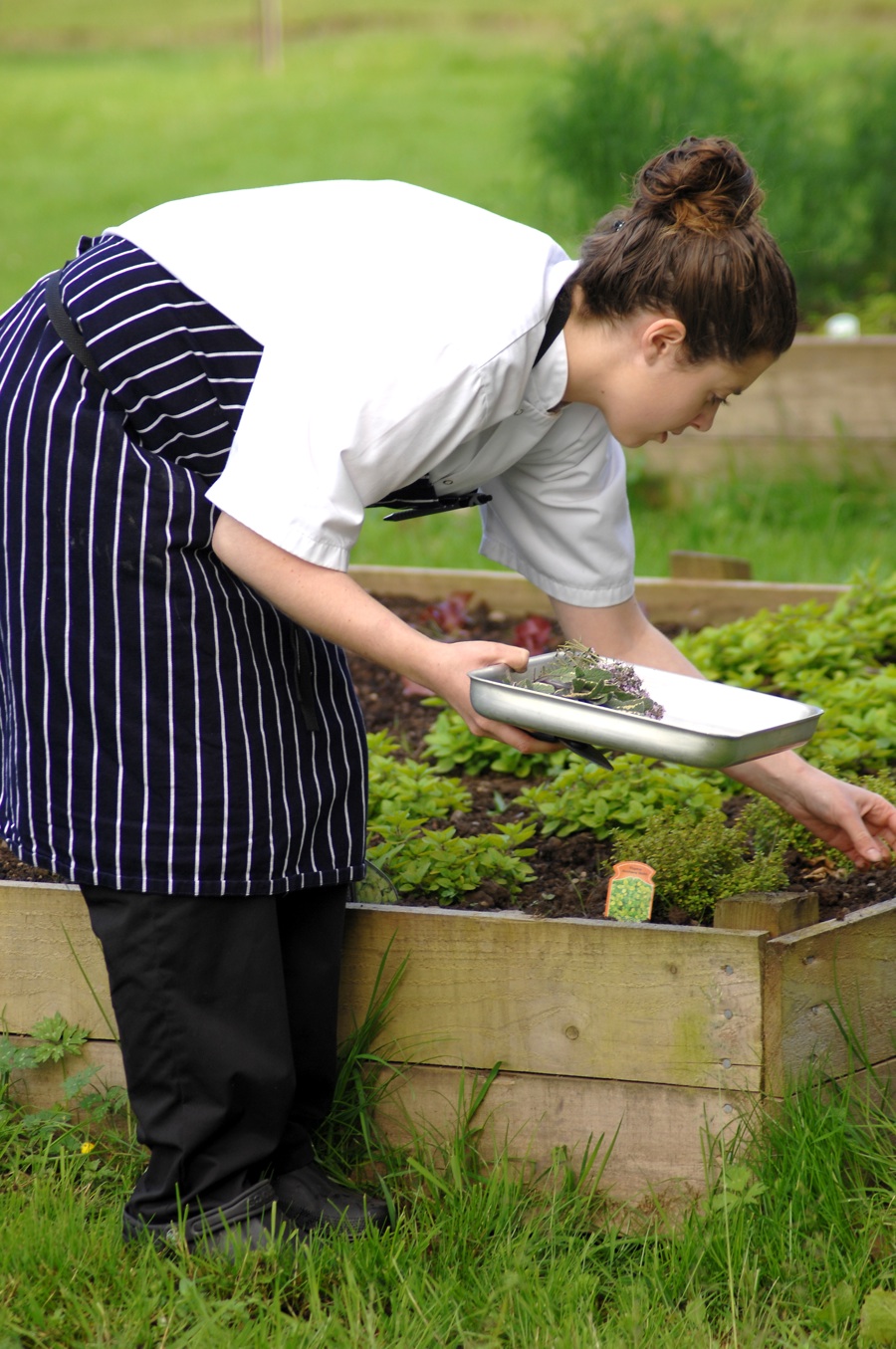
Gottgens’s Tasting Menu is only available when
he is in
the kitchen—which is most of the time, since, he states
matter-of-factly, that he needs only about three hours sleep a night.
On my visit the dinner began with a thick but modest-sized
cut of Ulg Salmon, served with bright, crispy micro greens. The fish,
which Gottgens describes as “escapee salmon” from the Atlantic just
over an hour away, had a pure flavor with a delicate hint of peat
smoke, and very little fat. Next came a delicate portion of
fresh-tasting line-caught
sea bass from nearby Loch Tarbet. It was accompanied by crisp baby
asparagus and carrots lightly drizzled with parsley oil.
I always enjoy the delicate taste of scallops,
but
Gottens’s version of seared Orkney Island scallops paired with a tiny
dollop of whipped sweet potato and garnished with a marvelous vanilla
butter broth was a whole new take on this classic seafood dish. The
combination of flavors brought everything there is to love about the
taste of scallops into perfect focus. The interesting pairings
continued with a small portion
of smoked St. Monan’s haddock with buttered leeks and a lightly fried
quail egg. Again, the matching of familiar flavors and textures created
a new intensity that made you wonder why no one had ever put them
together before.
Next came a game dish featuring leg of local
estate-raised hare matched with a rich wild mushroom duxelle. Unlike
your typical bland and flimsy, fam-raised white rabbit meat, the hare
meat was a
dark, juicy “steak” beautifully enhanced by the woodsy mushroom and
shallot sauce with hints of Madeira wine. A second entrée
featured a shoulder of lamb from
the Inn’s own herd. The meat had been steeped with South African tea
that brought out the subtle sweetness of the meat in a new and very
interesting way. Each course was beautifully paired with a variety of
wines from Ardeonaig’s own cellar comprised exclusively of South
African bottlings.
A nice palate-cleanser, the Granny Smith apple
sorbet
also bore Gottgens’s original touch with an intensified flavor that was
clear and simple and very specific. The dessert was a chocolate pudding
developed several
years ago especially for Queen Elizabeth’s visit with Nelson Mandela,
and while the pudding delivered every dark nuance one expects from good
chocolate, it was neither heavy nor overly sweet.
Starters
range from 8₤-11.50₤ and main courses 17.50₤-26.50₤.
Naturally,
no
jaunt through Scotland
would be complete without frequent stops at local distilleries. The Aberfeldy
Distillery in rural Perthshire is where the well-known
Dewar’s Scotch is created. Dewar’s has been one of the most popular
Scotches in the U.S. for many years, and its heritage goes back to
1898,
when this brand was established by the enterprising Sir John Dewar.
Here you can taste the beautifully well-rounded flavors of Dewar’s
12-year old single malt as well as the complex Aberfeldy single malt,
which is seldom seen here in America.
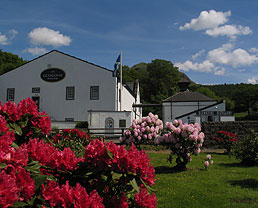 The Glengoyne Distillery (below) is located in
the midst of the sprawling farm fields of Dumgoyne about an hour
outside of Glasgow. As you step inside the lovely old rustic stone
building here, you’re greeted by the friendly scent of Golden Promise
Barley, the home-grown brand used exclusively by this distillery.
Unlike many other single malt makers, Glengoyne allows its barley to
air-dry rather than subjecting it to the heat and the smoke of peat
fires. The whiskey is then gently aged in Spanish and American oak
barrels yielding what I found to be one of the most appealing single
malts in the Highland area. It has a bright, clear, slightly sweet
flavor with hints of nuts and honey. A nice contrast to some of the
peatier single malts. Glengoyne offers well over a dozen different
Scotch
whiskies in its distillery store along with a chance to blend your own
single malt from small beakers of whisky flavors that you can try to
balance and meld.
The Glengoyne Distillery (below) is located in
the midst of the sprawling farm fields of Dumgoyne about an hour
outside of Glasgow. As you step inside the lovely old rustic stone
building here, you’re greeted by the friendly scent of Golden Promise
Barley, the home-grown brand used exclusively by this distillery.
Unlike many other single malt makers, Glengoyne allows its barley to
air-dry rather than subjecting it to the heat and the smoke of peat
fires. The whiskey is then gently aged in Spanish and American oak
barrels yielding what I found to be one of the most appealing single
malts in the Highland area. It has a bright, clear, slightly sweet
flavor with hints of nuts and honey. A nice contrast to some of the
peatier single malts. Glengoyne offers well over a dozen different
Scotch
whiskies in its distillery store along with a chance to blend your own
single malt from small beakers of whisky flavors that you can try to
balance and meld.
Built in 1794 even before the seaside
town of Oban itself sprung up along this craggy coastline, the Oban
Distillery (below)
has only two pot stills, making it one of the smallest
scotch producers 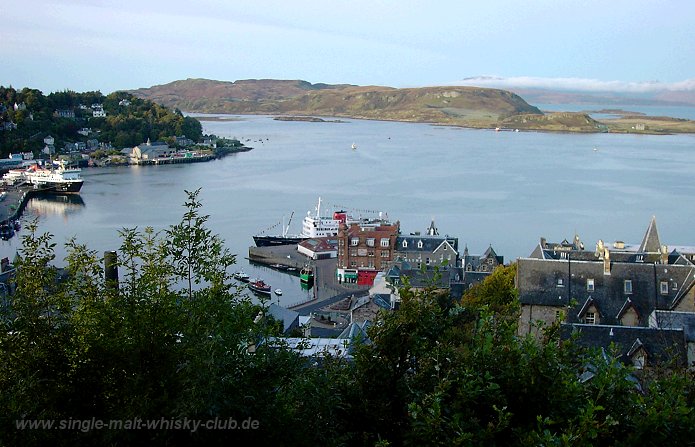 in
Scotland. The single malt made here falls somewhere
between smoky and sweet and because of its proximity to the ocean, many
tasters claim to detect a hint of sea salt.
in
Scotland. The single malt made here falls somewhere
between smoky and sweet and because of its proximity to the ocean, many
tasters claim to detect a hint of sea salt.
The Town of Oban itself seems mostly a
summer resort location with a busy waterfront lined with old and new
hotels and seafood restaurants. It is also a major port year-round for
ferries to the Scottish islands. The City of Glasgow is as
cosmopolitan as the
Scottish countryside is pristine and rural. Many of the City’s
beautiful old Victorian structures now house sophisticated restaurants
and night spots. The Malmaison on West George
Street qualifies as both
with a stylish bar, brasserie and hotel set in a Gothic building in the
heart of town.
Despite its somewhat dark and
“Kafka-esque” interior color schemes, the Malmaison exudes youthful
energy, and dinner in the downstairs brasserie was focused on the
freshness of local foods prepared under the expert guidance of Chef
Graham Digweed. Digweed’s roasted pumpkin soup with
chive cream was a welcome starter on a chilly Glasgow night; and his
grilled rosemary lamb, garnished with wholegrain mustard mash, was
delicious. I also sampled his glazed pumpkin gnocchi enhanced
with sage butter and wild rocket salad and was quite pleased with the
gentle melding of flavors.
Starters run
5/75-8.25, main course 12.95₤-17.50₤
Two Fat Ladies at the Buttery is
not
the ironic title of some Scottish novel. It’s the name of a small but
thriving restaurant franchise with three locations in Glasgow. The
quirky name is derived from the bingo call for 88. The restaurant where
we dined was at 652 Argyle Street. With its dark woods and stained
glass windows, it provided a cozy, Victorian setting for a
straight-forward, contemporary menu. The options were minimal:
Starters included soup of the day; squid, pancetta, mussel and radish
salad with bacon bits; or a mixed game stew.
Main courses featured items like lemon
and thyme-roasted chicken suprême with a shallot and mushroom jus;
roasted Shetland salmon wrapped in bacon came with creamed savory
cabbage; and the Estate of Mey rib-eye steak was perfectly grilled and
sprinkled lightly with peppercorn sauce.
Desserts were apple and blueberry
crumble tart with vanilla ice cream; a raspberry cheesecake; or a
selection of cheeses with oatcakes. If none of the dishes at the Two
Fat Ladies break any new culinary ground, everything hues
to classic tradition without a single misstep.
The other two other
locations are at 88 Dumbarton Road and 118a Blythswood St. in Glasgow.
Starters run
£4.50-£9.95, main courses £17.50-£22.50.
Robert Mariani is a freelance writer
living in Bristol, Rhode Island.
~~~~~~~~~~~~~~~~~~~~~~~~~~~~~~~~~~~~
MY
10 FAVORITE ROMANTIC RESTAURANTS AROUND THE WORLD
by John Mariani
I don't think I've ever actually
taken my wife to a restaurant on St. Valentine's Day for the simple
reason that the restaurants are overrun with dewy-eyed couples
expecting things like a complementary glass of cheap Champagne, little
chocolate cakes in the shape of hearts, and a single red rose at
dinner's end--all for far more than a usual night out at the same
restaurant costs. But I do take her out sometime during the week
of St. Valentine's Day so that we can enjoy the time together without
any of the rigamarole attached to such a highly commercialized
feast. Here, then, are some of my favorite, most romantic
restaurants in the world--in no particular order--where I'd take the
woman I love any night of the year.
Barbetta, NYC--a gorgeously
appointed series of dining rooms and a unique flower garden that opens
in good weather. The food is Piedmontese, the winelist one of the best
for Italian wines in the city.
Azul, Miami--Brilliant design and
great fusion cuisine make this dining room looking out over the
brilliant blue water the most enchanting in the city.
Auberge du Soleil, Rutherford,
CA--Sitting here on the terrace verlooking the vineyards of Napa Valley
and feasting on California cuisine and a daunting winelist makes this
the most romantic venue I know in northern California.
Montagna, Aspen--The fine
dining room at Aspen's Little Nell Hotel with a panorama on the Rockies
and ski slope here, this also has some of the finest cuisine, viua chef
Ryan Hardy, in the west.
Wheatleigh, Lenox,
Massachusetts--A 19th century mansion of remarkable and exquisite
design, Wheatleigh affords a candlelighted dinner overlooking
acres of New England greenery--or quiet snow in winter--with
deferential service rare in this country.
Ciragan Palace, Istanbul,
Turkey--The gorgeously appointed dining room here oversees the
Bosphorus in all its majestic, flowing beauty and you are serenaded by
the singing of prayers from the mosques while dining on
Turkis-and-French cuisine.
The Ritz Dining Room,
London--Over-the-top, effusively baroque and Edwardian decor and huge
windows on the green, the Ritz dining room, with its impeccable service
and live music is a rare enchantment of truye Btitish design.
Les Ambassadeurs, The Crillon
Hotel, Paris--Had Les Ambassadeurs only had its grandeur, its marble
and mirrors, gilt and murals, it would be breathtaking. Add to
that a panorama on the Place de la Concorde and exquisite cuisine,
widely spaced tables, and perfect service, and you cannot do better in
Paris.
Gritti Palace
Ristorante, Venice--The Grand Canal before you, San Marco
behind you, wondrous Italian cuisine with real flair--you need more?
Dal Pescatore,
Cuneto-sul-Olio, Italy--An expaned farmhouse of complete charm with the
Santinit family taking care of your every wish and some of the finest
food and wine in Italy make this out-of-the-way place very very
romantic.
~~~~~~~~~~~~~~~~~~~~~~~~~~~~~~
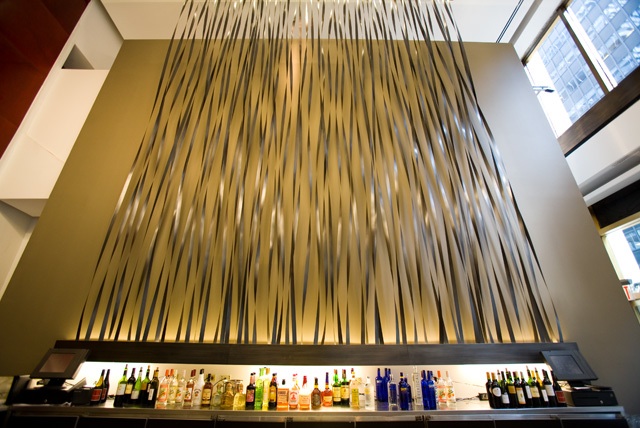 VERMILION
VERMILION480 Lexington Avenue
212-871-6600
www..vermilion.com
When Chicago
Restaurateur
Rohini Dey and Executive Chef Maneet Chauhan opened the original Vermilion in
Chicago four years ago, I wrote in praise of a new and
exciting idea of combining the techniques of Indian and Latino
cuisines, which share many affinities, not least the chile pepper,
which got to India from the Americas some time in the 17th
century. These two beautiful Indian women also gave Chicago a
stunningly modern design, completely different from any other Indian
restaurant in America, which are always draped in paisley fabrics and
set with bronze statues of elephant gods. You find none of that here.
Now they have opened an even more
spectacular restaurant in midtown Manhattan, and the cuisine is now
more
refined and more imaginative than ever. Indeed, Vermilion New
York immediately leaps to the front ranks of Indian restaurants in this
country, comparable only to the superb Washington DC restaurant
Rasika. Both share a commitment to carefully prepared and
presented food and drink within striking décor. In the case of
Vermilion NY, the restaurant is spread over two split levels,
downstairs the lounge, with communal seating, upstairs the main dining
room, itself split 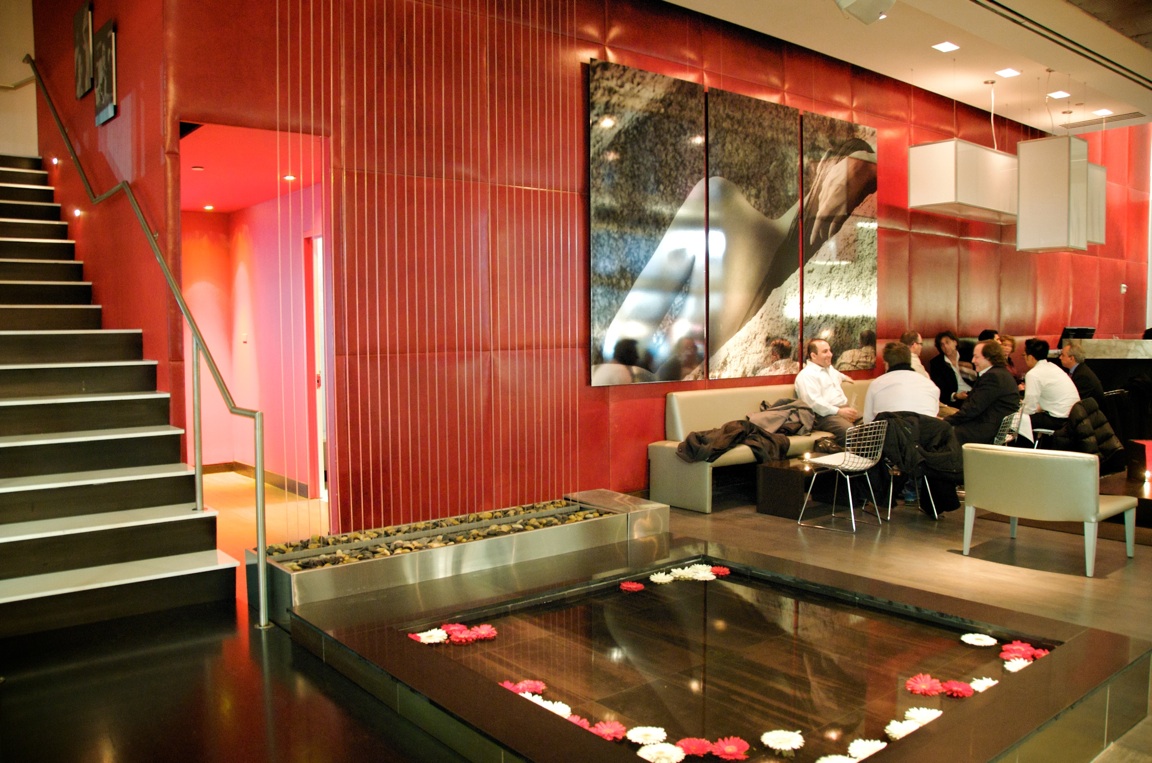 into
two sections, one dreamily lighted, the other
brighter, both looking out wide expanse of glass onto the rush of
Lexington Avenue.
into
two sections, one dreamily lighted, the other
brighter, both looking out wide expanse of glass onto the rush of
Lexington Avenue.
Dey herself, who has a Ph.D
in economics, worked in development economics for
the World Bank and as a Management Consultant with McKinsey &
Co., led the design of Vermilion in collaboration
with Chicago architects Searl, Lamaster and Howe, highlighted by
oversized black-and-white photographs by India’s leading fashion
photographer, Farrokh Chothia. The space also contains a gorgeous
curtain of water, a 22-foot metal mesh chandelier, metal cable and
backlighted
bar, and floating ponds
on both levels.
One
of the real attractions here is the exotic
cocktail list, which use herbs and spices with amazing subtlety, as in
the cucumber
mint martini, the blueberry cardamom fizz, and the pani puri margarita,
all of which may actually be tasted in small shot-like flights. The
winelist,
very fairly priced, focuses on South American and Spanish boutique
wines along with California bottlings. There is even a selection of
wines from India. And, of course, there are some fine Indian
beer.
 Chef Chauhan has cooked at The Taj Group, Oberoi
Hotels, and Le Méridian, while Chef de Cuisine Ipshita Pall
apprenticed at Chicago's Vermilion. They
bring an exceptional vivacity to the food here in New York, and they do
not push the Latino connection too
much. For this is Indian cuisine brought to a very high level of
refinement, not as a movement away from tradition but as an
incorporation with global influences that show the myriad styles Indian
food truly represents. Appropriately, the name of the restaurant
celebrates the
color red--sindoor--that is
central to femininity in India, most often
seen as the dot on the foreheads of Indian women.
Chef Chauhan has cooked at The Taj Group, Oberoi
Hotels, and Le Méridian, while Chef de Cuisine Ipshita Pall
apprenticed at Chicago's Vermilion. They
bring an exceptional vivacity to the food here in New York, and they do
not push the Latino connection too
much. For this is Indian cuisine brought to a very high level of
refinement, not as a movement away from tradition but as an
incorporation with global influences that show the myriad styles Indian
food truly represents. Appropriately, the name of the restaurant
celebrates the
color red--sindoor--that is
central to femininity in India, most often
seen as the dot on the foreheads of Indian women.
You begin with small plates--tapas, if
you will--that I could easily make an entire meal from: blue
corn-crusted scallops with kali
mirch
calabasa, and a goat's cheese  puree; duck vindaloo
arepa, brushed pomegranate molasses in a curry
leaf with mango; mussels in a coconut chili and coconut broth infused
with curry leaves; fried artichoke pakoras with eggplant chili coconut
sauce; pani puri
with crispy chaat flour
shells, potato,
and chili mint water. If I don't describe these any further it is
because their flavors and textures are so wonderfully complex.
puree; duck vindaloo
arepa, brushed pomegranate molasses in a curry
leaf with mango; mussels in a coconut chili and coconut broth infused
with curry leaves; fried artichoke pakoras with eggplant chili coconut
sauce; pani puri
with crispy chaat flour
shells, potato,
and chili mint water. If I don't describe these any further it is
because their flavors and textures are so wonderfully complex.
From the fiery tandoor oven come various seekh kebabs of
minced beef, lamb
chops done in the southern Mysore style, and chicken in a
creamy
tomato-fenugreek sauce. Breads, buttery and puffy, crisp and
soft, come to the table waftin the aromas of yeast and char.
For main courses there are lovely, colorful
dishes like sesame-and-peanut crusted ribeye of beef; pork belly laced
with spicy garam masala;
jumbo crab shredded with crêpes and huitlacoche and red quinoa;
lobster Portuguese (right) is
a Goan dish with coconut rice and a n
eggplant-tomatillo chutney, while Sri Lankan fish is cooked with 16
spices; Mangalorean lamb shank gassi
is braised to succulence and served with mango pach puran rice.
And so goes the menu--nothing you've ever eaten
before, nothing quite so tantalizingly presented. Then come
desserts in the same fashion, like "Vermilion hedonism"--a dark
chocolate molten cake, chili-masala
orange-blueberry sorbet; a mora
berry mousse; cumin ice cream, and channa chor brittle.
Vermilion
is a strikingly original restaurant, and the three women being so
intimately
involved in every square inch of the décor, the plates, and the
cooking have transformed Indian cuisine the way, two years ago, Michael
Psilakis transformed Greek food in this country at Anthos, and,
20 years ago, Gilbert LeCoze did with French seafood at Le
Bernardin. Vermilion is the kind of place where, even if you've
eaten all over the world, including India, you will still be surprised,
delighted, even mesmerized.
Vermilion is open for lunch Mon.Fri. and for dinner nightly. Appetizers
run $8-$14, main courses $22-$34. There are tasting menus at $70 and
$80.
NOTES FROM THE WINE CELLAR
Navarra
Wines quickly adapt to 21st century global market
by John Mariani
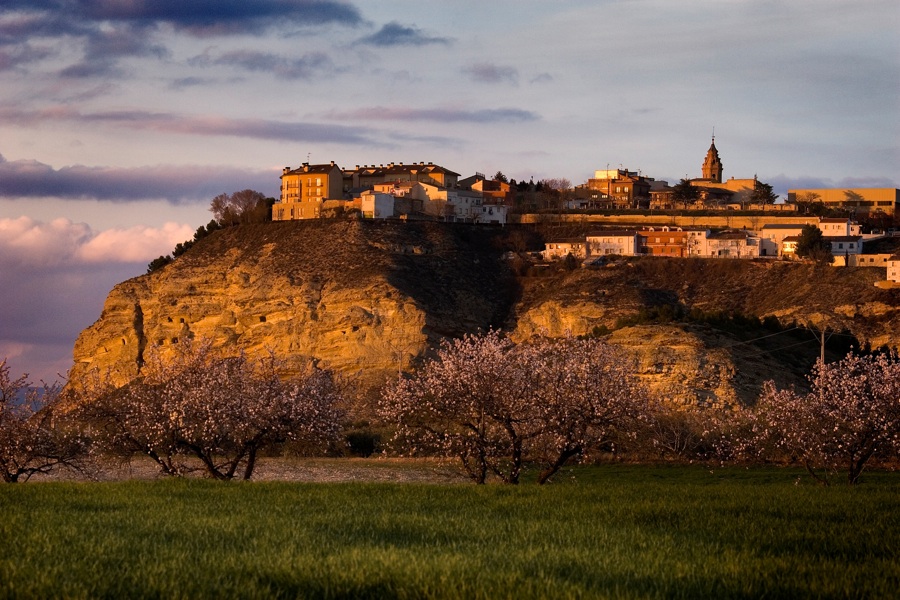
This mountainous northern region, made famous by Ernest Hemingway in his novel The Sun Also Rises, ranges from the eastern Pyrenées to the edge of Rioja Baja, with Pamplona as its principal city. Today the region’s total wine production has reached 60 million litres from 18,000 hectares separated into five zones—Valdizarbe in the north central; Tierra Estella in the northwest; Baja Montaña in the Northeast, which makes the best rosados; Ribera Alta around the town of Olite; and Ribera Baja in the south.
For an article on visiting and dining out in Pamplona, click here.
According to Ana Laguna, wine
expert with the
Navarra School of Tasting, 70 percent of the region’s grapes are
indigenous—mainly tempranillo, garnacha, graciano, and mazuelo for the
reds, viura and moscatel de grano menudo for the whites—and 30 percent
international varietals. Ninety-four percent of the wines produced are
red.
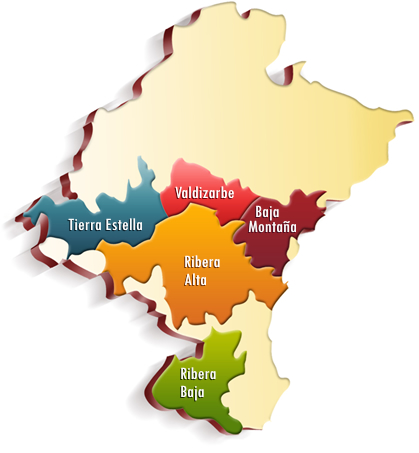 The wines I was most impressed by were
in fact the rosados, with
their true rose color, a fragrant nose, and
flower-and-mineral flavors picked up from the red limestone that covers
the region’s vineyards. Ochoa—one
of the more notable modern wineries there—makes an enchanting rosado for summer. Its 2007 ($10),
with 13 percent alcohol, is now as ready to drink as it ever will be,
and a perfect wine with tapas, shrimp, and lobster. Every bit as good,
a gorgeous pink color with a hugely satisfying bouquet, was Campos de Enanzo 2007 ($10), whose
garnacha grape juice is derived from a ”bleeding technique” of sheer
gravity rather than mechanical pressure.
The wines I was most impressed by were
in fact the rosados, with
their true rose color, a fragrant nose, and
flower-and-mineral flavors picked up from the red limestone that covers
the region’s vineyards. Ochoa—one
of the more notable modern wineries there—makes an enchanting rosado for summer. Its 2007 ($10),
with 13 percent alcohol, is now as ready to drink as it ever will be,
and a perfect wine with tapas, shrimp, and lobster. Every bit as good,
a gorgeous pink color with a hugely satisfying bouquet, was Campos de Enanzo 2007 ($10), whose
garnacha grape juice is derived from a ”bleeding technique” of sheer
gravity rather than mechanical pressure.
Ochoa, an innovative winery whose
vineyards date to the 14th century, also makes a very fine 2005 single
vineyard blend of garnacha and graciano ($15), a grape that fell out of
favor because of low yields, now appreciated for just that quality,
resulting in a wine of depth, rich tannins, and dark cherry flavors. A
bottle of Ochoa’s Reserva 2001
(about $18), a blend of 70 percent tempranillo, with merlot, and
cabernet sauvignon, showed signs of oxidation, though its Crianza 2005
($15), which is 100 percent tempranillo ($$$) was stunningly rich and
balanced in fruit, acid, and tannins. At the same level of elegance and
vivacity was the Artajona Argaray
Crianza 2005 ($12).
I can’t claim much experience with wines made from
Navarra’s mazuelo grape (elsewhere called carignane), but I found the Señorio de Sarria Viñedo No.
8 2005 ($20) very tannic right now but there was plenty of
pleasing dark fruit at the back of the palate.
The most distinctive wine of the tasting was Nekeas El Chapparal 2007 ($15), 100
percent garnacha, that showed how the spice and black pepper of this
grape elsewhere known as grenache is a direct result of terroir, in
this case the Nekeas Valley protected by the Sierra Perdon mountains
from the cold winds of the Pyrenees.
I found it interesting that almost every
Navarra wine I sampled, here and in Pamplona, was labeled no higher
than 13.5 percent alcohol. In fact, an Inurrieta 100 percent graciano
($14), with no vintage listed, was a little too brassy and plummy, at
14.5 percent alcohol.
Keeping the alcohol under 14 percent means the
producers are not trying to compete with the over extracted reds that
are part of some other Spanish vintners’ global plans. Instead,
Navarra has achieved a fine balance of the old with the new, making
fresh, fruity wines that have not lost the taste of their regional
terroir.
~~~~~~~~~~~~~~~~~~~~~~~~~~~~~~~~~~~~~~~~~~~~~~~~~~~~~
NEXT WEEK HE'S MIXING UP A NICE BATCH
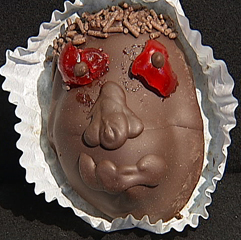
OF FUNKY HITLER MARZIPAN
In NYC Ted Kefalinos, proprietor of Lafayette French Pastry, allegedly asked a customer, "Would you like some `drunken negro heads' to go with your coffee? They're in honor of our new president. He's following in the same path of Abraham Lincoln; he will get his." Later Kefalinos told a Fox news reporter, "I called them Drunken Negro Heads. What's the problem with that? On Inauguration Day I thought it would be cool to change the name to Obama Heads. I just changed it for the day." Kefalinos insisted that the cookie is "not unflattering. I think it's a fun face. And anyone who says anything else should be ashamed of themselves," insisting that he couldn't be a racist because "my brother-in-law, he's Cuban." People in the neighborhood called for a boycott of the pastry shop.
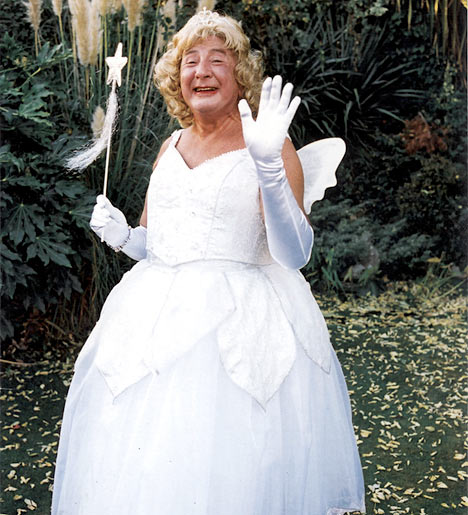 WHY
THERE'LL ALWAYS BE AN ENGLAND
WHY
THERE'LL ALWAYS BE AN ENGLAND
"I’m fed up with readers writing that I never go north of
Watford. This is the fourth review this year of a northern place. With
at least three more to come. I’m also fed up with readers telling me
I’m a name-dropper. So are you. You talk about the people you meet. Mrs
Betty Twiddle the shopkeeper, Elisa Birdwalk the lawyer, Rog Makepeace
the used-car dealer, Mr and Mrs Plod your neighbours. They’re names.
You drop them. I live my life among famous people. That I mention them
when recording my wanderings is no more name-dropping than
you."—Michael Winner, Sunday Times
(Aug 31, 2008).
Winner in his Christmas
card outfit.
* On Feb. 22 The Bistro Garden @ Coldwater in Studio City, CA, is holding a Gala Academy Awards Party with a glass of champagne followed by buffet. A ballot drawing for the winners offering dinner for 4 and more. $55 pp. Call 818-501-0202.
* In NYC, Cercle Rouge Brasserie introduces a Mon. night prix fixe of 3 courses for $25 and 25% off all wines. In addition, a selection of bottles will also be available at $25. Call .212-226-6252.
* In Boulder, CO, Laudisio
is opening its extensive wine cellar to the public, by way
of a monthly wine pairing, most with 5 courses and 6
wines. $60-$75 pp. Feb 23: " A Tuscan Evening.”
Call 303-442-1300.
* Beginning March 3, Bay Area Chefs and Farmers
will host the 1st annual “A
Moveable Feast: Twelve Chefs Celebrate Six Farmers in a Series of
Seasonal Suppers.” Each month, two top chefs will collaborate
with a local farmer to create an extraordinary to benefit The Center
for Urban Education about Sustainable Agriculture's mission of
promoting a sustainable food system through the operation of the Ferry
Plaza Farmers Market and its Education Programs. Chefs include Greg
Dumore, Ame; Mark Sullivan, Spruce; Loretta Keller, Coco500 and The
Moss Room and Dominique Crenn, Luce, et
al. Each dinner will be $80 pp, $100 with. Visit
http://www.brownpapertickets.com/event/51667.
* In NYC, Chef Riccardo Buitoni, of Aurora Soho, will host a series of monthly, regional Italian culinary nights every Mon. His Piemonte, 3-course at $40 pp. incl. wine pairings. Call 718-388-5100 ; www.auroraristorante.com
* On March 5 in Austin, TX, The Driskill Grill will hold a ZD
Vineyards Wine Dinner & Fundraiser With 15% of fee going to the
Leuze Family Endowment for a Cure for Lymphoma. Chef Jonathan Gelman
will pair dinner with ZD wines yet to be released, reserves and
the Abacus Cabernet Sauvignon ’92-’07 solera blend. Regional
Sales Manager for ZD, Kendra Gillette, will host the dinner. $98
p. Call 512-391-7041.
* Beginning in March, Rancho
de San Juan between
Taos and Santa Fe, NM, will present 4 monthly “Passport
Dinners”
each representing a culinary destination: March 7 – Exotic India;
April 25 – Spicy Oaxaca, Mexico; May 30 –Viva La France; June 20 –
That’s Amore, Italy. One Passport for all 4 dinners is priced at $200
pp, single dinners are $65. Call 505- 753-6818 or email
ranchosj@windstream.net. Visit www.ranchodesanjuan.com.
*The Wine Road (formerly
known as The Russian River Wine Road) will be hosting its Annual
Barrel Tasting
event, March 7-8 and 14-15, with over 100 wineries from the region.
Each winery
opens its cellar doors, offering wine lovers a chance to meet with
winemakers, sample wines directly from the barrel, and purchase
“futures” at a 25-30% discount. Visit www.wineroad.com. $20 pp.
* Kiawah Island Golf
Resort will have Charlie Trotter host the opening
event of its March 13-15, “Gourmet & Grapes” food & wine event
to benefit the Medical U. of South Carolina Hollings Cancer
Center. Accommodations start from $2219 pp. Chef Expo Day
Passes $300 pp. A Sat. Lunch and Seminar Pass $125. Visit
www.kiawahresort.com or call 800-654-2924.
* Innovative Dining
Group of Los Angeles is offering 3- and 4-course dinners
ranging from $25 - $40 pp at incl. BOA Steakhouse; Sushi Roku, Sushi
Roku, and Katana. Visit www.sushiroku.com.
Everett Potter's Travel Report:

~~~~~~~~~~~~~~~~~~~~~~~~~~~~~~~~~~~~~~~~~~~~~~~~~~~~~~~~~~~~~~~~~~~~~~~~~~
Eating Las Vegas is the new on-line site for Virtual Gourmet contributor John A. Curtas., who since 1995 has been commenting on the Las Vegas food scene and reviewing restaurants for Nevada Public Radio. He is also the restaurant critic for KLAS TV, Channel 8 in Las Vegas, and his past reviews can be accessed at KNPR.org. Click on the logo below to go directly to his site.
~~~~~~~~~~~~~~~~~~~~~~~~~~~~~~~~~~~~~~~~~~~~~~~~~~~~~~~~~~~~~~~~~~~~~~~~~~~
Tennis Resorts Online: A Critical Guide to the World's Best Tennis Resorts and Tennis Camps, published by ROGER COX, who has spent more than two decades writing about tennis travel, including a 17-year stretch for Tennis magazine. He has also written for Arthur Frommer's Budget Travel, New York Magazine, Travel & Leisure, Esquire, Money, USTA Magazine, Men's Journal, and The Robb Report. He has authored two books-The World's Best Tennis Vacations (Stephen Greene Press/Viking Penguin, 1990) and The Best Places to Stay in the Rockies (Houghton Mifflin, 1992 & 1994), and the Melbourne (Australia) chapter to the Wall Street Journal Business Guide to Cities of the Pacific Rim (Fodor's Travel Guides, 1991). THIS WEEK: A Report on The Four Seasons Jackson Hole. Click on the logo below to go to the site.

Family Travel
Forum: The
Family Travel Forum (FTF), whose motto is "Have Kids, Still Travel!",
is dedicated to the ideals, promotion and support of travel with
children. Founded by business professionals John Manton and Kyle
McCarthy with first class travel industry credentials and global family
travel experience, the independent, family-supported FTF will provide
its members with honest, unbiased information, informed advice and
practical tips; all designed to make traveling a rewarding, healthy,
safe, better value and hassle-free experience for adults and children
who journey together. Membership in FTF will lead you to new worlds of
adventure, fun and learning. Join the movement.
All You Need to Know Before You Go
~~~~~~~~~~~~~~~~~~~~~~~~~~~~~~~~~~~~~~~~~~~~~~~~~~~~~~~~~~~~~~~~~~~~~~~~~
MARIANI'S VIRTUAL GOURMET NEWSLETTER is published weekly. Editor/Publisher: John Mariani.
Contributing Writers: Robert Mariani,
John A. Curtas, Edward Brivio, Mort
Hochstein, Suzanne Wright, and Brian Freedman. Contributing
Photographers: Galina Stepanoff-Dargery, Bobby Pirillo. Technical
Advisor: Gerry McLoughlin.
Any of John Mariani's books below
may be ordered from amazon.com by clicking on the cover image.
 My
newest book, written with my brother Robert Mariani, is a memoir of our
years growing up in the My
newest book, written with my brother Robert Mariani, is a memoir of our
years growing up in the For those of you who don't think of the Robert and I think you'll enjoy this very personal look at our --John Mariani |
 |
 |
 |
 |
 |
 |
© copyright John Mariani 2009
